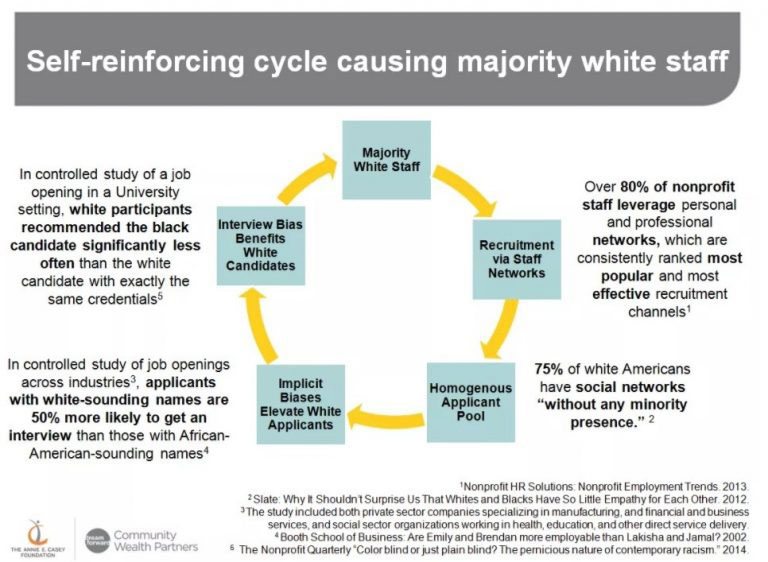
Editor’s Note: Here, Vu Le revisits the problem of the lack of diversity on nonprofit boards with some suggestions about how to think about and address the problem. He also provides a few vivid metaphors for the non-diverse board that might help motivate you to move things along, if necessary, on your own board. (Think of your board as a 200-lb. seitan pig.) For more on this, please see our article here and our webinar here.
Hi, everyone. Apologies in advance for the grumpiness of this post. In addition to Hurricanes Harvey, Irma, and Jose, every week brings some sort of fresh horror from this administration. The president’s decision to end DACA is the latest injustice we as a sector and as a society must add to our growing list of injustices to fight. 800,000 Dreamers (who had no choice in being brought into this country) are in limbo, not to mention the lives of millions of their families. Please read this article written by a Dreamer and call your elected officials. The voices of people in support of ending DACA are loud, so we must be louder.
Meanwhile, we have some other challenges in the sector we have to deal with. BoardSource just released its report on board diversity, and the statistics are frustrating, disappointing, and somewhat anger-inducing (like this season’s Game of Thrones—seriously, Arya and Sansa?!) Here are a few highlights from the survey of 1378 nonprofit executives and 381 board chairs, though I highly recommend you read the full report.
- 27 percent of all orgs that responded have zero people of color on their board.
- 65 percent of executives and 41 percent of board chairs report that they are dissatisfied with their board’s racial and ethnic diversity.
- Things haven’t changed in over two decades. According to BoardSource, “Past BoardSource studies found that boards were 86 percent white in 1994, 91 percent white in 2004, 86 percent white in 2007, 84 percent white in 2010, and 82 percent white in 2012.” In 2015, it was 89 percent; 2016, 84 percent. (We’ll talk about the equally dismal ED/CEO diversity another time).
- 79 percent of EDs/CEOs say that expanding racial and ethnic diversity is important or very important to advancing mission.
HOWEVER, despite these mostly horrifying numbers, there are still even more horrifying numbers:
- Only 24 percent of executives and 25 percent of board chairs say demographics are a high priority for board recruitment.
- Only 21 percent of executives and 23 percent of chairs report “change or strengthen recruitment practices,” when asked what they needed to do to improve their boards. Among all-white boards, only 21 percent of executives indicated it as a top-three priority.
- About 25 percent of respondents indicate that they are somewhat or extremely dissatisfied with their board’s racial or ethnic diversity while simultaneously indicating that demographics is not a high priority in board recruitment. Which is ridiculous and incomprehensible, like the mission beyond the Wall on this season’s Game of Thrones.
OK, we need to have a serious talk. The lack of diversity on boards is no longer just annoying. It is a critical issue. Because I am grumpy, let me put it this way: If your board is not representative of the community you claim to serve, then you are furthering the injustice you seek to fight.
This goes for foundations too.

I know it sounds harsh. Your board members have good intentions. They care about equity and social justice. But good intentions are not enough. Whether we like it or not, nonprofit and foundation boards wield a tremendous amount of influence on this work. And whether we intend to or not, the lack of board diversity trickles down and has some wide-ranging consequences:
Because of the self-reinforcing cycle, mostly-white boards are likelier to hire white EDs/CEOs, who then are likelier to hire white staff, so now there’s lack of staff diversity in the sector as well.
- Mostly-white boards of foundations are likelier to fund organizations that are also mostly white, furthering a system where the communities most affected by injustice get the least resources to address it.
- Mostly-white boards and staff of nonprofits and foundations are likelier to ignore the people most affected by injustice and implement ineffective strategies based on second-hand knowledge
- Mostly-white boards of foundations and nonprofits that serve marginalized communities are likelier to perpetuate a white savior complex, an insidious dynamic that prevents true social justice from being realized.
As I said, I don’t doubt anyone’s intention. Few of us are doing these above things on purpose; a lot of these challenges are due to implicit biases or other factors. Our sector is full of good people trying to do good for our communities. But having a board with zero people of color trying to serve a community with lots of people of color is like:
- Having a bunch of really sensitive dudes, and no women, work on women’s health issues: “We have sisters and mothers, whom we love, so we have an understanding of what’s best for women.”
- Having a dozen people who have never been in the ocean open a surfing school: “We saw a lot of Baywatch growing up, and it seems all you need is a board and some red clothing.”
- Having a group of lifelong vegans plan the annual pig roast: “How about we create a 200-pound loaf of seitan, and shape it into a pig?”
Except for the last example—a 200-pound seitan-pig roast would be amazing and is now #19 on my bucket list!—these scenarios are bizarre or offensive or both. And yet, it seems perfectly fine for us to have mainly-white foundation and nonprofit boards in a sector focused on addressing systemic injustice, which disproportionately affects people of color. How is that OK? How are we OK with the fact that in over two decades—as our communities greatly diversify—our boards are still vastly white?
800,000 children are at risk of being deported from the only country they have ever known, white supremacy and Nazism are on the rise, and fear and violence are now the daily reality for many communities. The nonprofit sector cannot effectively address these and other challenges if we don’t do something about our pathetic sector-wide diversity problem.
So, you may be thinking, “Well, what’s the solution then?” Here’s the thing: We can’t solve this and other diversity challenges unless we understand that diversity is an adaptive problem, not a technical one. So if you’re hoping there’s a list of seven simple things we all need to do to be more diverse—“Tip 5: Have better food at your board meetings. Cheese and veggie platters at 6pm is culturally insensitive”—you’re going to be disappointed. This is a problem that requires us all to look at history, philosophies, cultural dynamics, etc., within our orgs and within society in general.
[clickToTweet tweet=”Let’s all stop whining about the lack of board diversity and start doing stuff differently.” quote=”Let’s all stop whining about the lack of board diversity and start doing stuff differently.” theme=”style3″]
Sign up for our free newsletters
Subscribe to NPQ's newsletters to have our top stories delivered directly to your inbox.
By signing up, you agree to our privacy policy and terms of use, and to receive messages from NPQ and our partners.
Still, just because it’s a complex problem, doesn’t mean we can’t all start taking actions immediately. Here are few suggestions I came up with for what each of our organizations must do. BoardSource has other great advice too. Discuss this issue with your board. We all need to do better. Seriously. Let’s all stop whining about the lack of board diversity and start doing stuff differently.
1. Analyze your board demographics and whether your board is demographically representative of the community you serve. If you’re serving a majority-Latino community, is at least half your board members Latinos? I know this issue is complicated. Some communities are mainly white, and so clients are mainly white, so boards are mainly white, and it’s unrealistic to ask these boards to greatly diversify. But if your community is significantly of color, but your clients are mostly white and so board members are mostly white, then you’re going to have to do a lot of thinking about whether you are achieving your mission. We also need to talk about disability, LGBTQ, age, gender, and other identities.
2. Train your board on race, diversity, and implicit biases. We can’t talk about these challenges in the sector when our board members and staff are not on the same level regarding concepts and terminologies. Every nonprofit board and staff need to attend these trainings so we all at least have common language and concepts to discuss these issues, before we are even able to address all the damage we may possibly be causing without even realizing it due to our unconscious biases. These trainings and conversations need to be ongoing. Build them into your board calendar/workplan.
3. Get over color-blindness and prioritize demographics. The fact that nonprofit leaders indicate that diversity is good, admit their own diversity level sucks, and yet refuse to prioritize diversity in recruitment is indicative of this color-blind mentality. As was discussed in an earlier post, color-blindness is a form of racism. Yet too many board members haven’t had this conversation. And so it manifests as “We don’t care about our board candidates’ race or ethnicity, just what skills and qualifications they bring to the board.” That’s like saying, “We don’t care what gender you identify as; we only consider your skills when working on our mission of improving women’s health.” You will not have a diverse board until you get over color-blindness and prioritize diversity in recruitment.
4. Reduce the influence of money in determining who is on your board. This will be a separate post for later, but the influence of money in the nonprofit sector has grown too large. Look, I get it. I’m an ED, and this is the sallow, haunted face of a nonprofit director constantly freaking out about funding. But many boards and executives now consciously or unconsciously home in on whether a board candidate has money, connections to money, or fundraising skills when recruiting board members as the number one criterion. The connection to the larger community, to the community being served, plays a secondary role. This leaves out many diverse candidates, because there is still a huge racial wealth gap. And those with fundraising skills and experience are still overwhelmingly white.
5. Understand and change your board culture. As I mentioned earlier in, “Why we need to stop asking ‘What do you do?’”
[We] wonder why our boards are not diverse. Maybe it’s because many people from diverse communities come from a To-Be culture, where relationships are the most important part, and actions do not happen until connections are strong. If we don’t understand this, we will likely continue struggling to get diverse candidates on our boards.
Read that article and have the conversation with your board about whether your board practices—Robert’s rules, strict agendas, no time for relationship-building, ubiquitous cheese and veggie platters—are driving candidates away.
6. Make sure your next three board members are diverse. If you are serious about diversity, put a moratorium on bringing on the board people from demographics that you have plenty of already. Just commit to not accept the next few candidates unless they are from the diverse demographic you seek. “But…Eddie has connections to potential donors!” Put him on the development committee. It’s also important you bring in a group of diverse people because it sucks for someone to be the only diverse member on a board. You feel isolated and tokenized. Believe, I’ve been there, and it’s horrible, no matter how well-meaning the rest of the board is.
7. And if you’re from an overrepresented demographic, maybe DON’T JOIN A BOARD. We keep talking about bringing on diverse board members and not enough about the spaces that are constantly taken up by board members who shouldn’t be there. Assess your role. Of course, there are always exceptions, but if you’re white, and a nonprofit’s board is 80 percent white, you may not be needed, no matter how much you love the mission, and how much they love you. You may be taking up space that should go to another person. If you’re a dude, and the board is mainly dudes, maybe don’t join this board. If you don’t identify as a person with a disability, and the board of a disability organization you want to join does not have people with disabilities, maybe don’t join. And so on. You can still be involved. Give the organization money. Volunteer. Be honest about why you decided not to join; let them know you’d love to join later when they are more representative of the community they are serving.
I’m sure there are other things we all need to do to. Write your suggestions and thoughts in the comment section. We all need to do better on this. The board structure, for all its challenges and weaknesses, is the governance system we currently have, and board members have a lot of influence on the entire sector, and thus on the communities we serve. Board diversity is no longer a nice-to-have; it determines whether we advance in our fight against injustice, or whether we inadvertently perpetuate that same injustice.
Now, if you’ll excuse me, I have some seitan sculpting to do.
Thanks to Vu Le for letting NPQ reprint this from his blog, found at NonprofitAF.com












